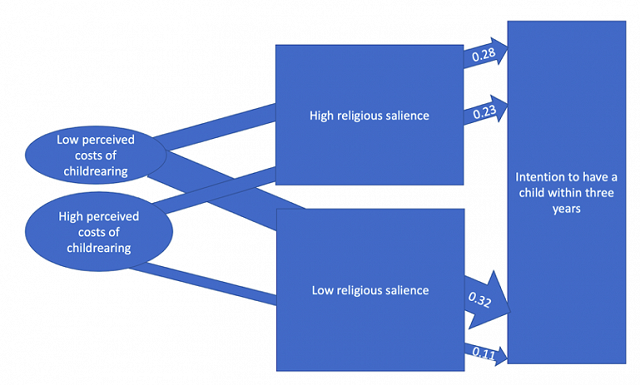Highlights
- Per a new study, people for whom religion is more important in their lives perceived greater benefits to having kids and lower costs. Post This
- Among people perceiving high childbearing costs, those with high religious salience are more than twice as likely to intend to have a child soon than those with low religious salience. Post This
There is a strong tie between religiosity and childbearing across cultures and countries, but there is nonetheless still much we don’t understand about how faith influences fertility. Christoph Bein, Monika Mynarska, and Anne Gauthier’s recent research filled one of the gaps in our understanding by showing that, at least in Poland, perceived costs of childbearing have little effect on the plans of those who find religion important, while heavily dissuading others. Their work may help explain the limited efficacy of Poland’s aggressive pro-natalist policies.
Bein and his coauthors carefully teased apart the interplay of religion and the perceived benefits and costs of childbearing. Costs refer to emotions like stress, worries and anxiety, and also to monetary expenses, physical tolls of pregnancy, and lost time for leisure. Benefits similarly have an emotional layer, i.e. affiliation, accomplishment, novelty, connection; as well as more instrumental aspects, such as economic utility and fulfilling norms of morality and religion. This study measured religion by the reported importance people placed on religion in their own lives (academics call it “religious salience”), rather than measuring religiosity by the frequency of religious service attendance.
First, the research team measured the effect religious salience has on fertility intentions. Not surprisingly, people for whom religion is more important in their lives perceived greater benefits to having kids and lower costs.
Second, regardless of religious salience, about 30% of those who perceive higher benefits plan to have children soon (within the next 3 years), but less than 7% who perceive low benefits intend to have children soon. Basically, people who see more worth in having children want them compared to those who don’t.
It would have been fairly easy to assume these two initial findings. However, the third point the study makes is more provocative. High perceived costs do not greatly sway more religious people in their fertility decisions the same way they do less religious people. Among people with low religious salience, about 11% intend to have a child soon in the face of high costs, compared to 32% who perceive lower costs. This almost three-fold difference among less religious people is comparatively tiny among more religious people: 23% of more religious people facing high perceived costs versus 28% of those facing low perceived costs intend to have a child soon. Below is a graphic to illustrate the study’s findings.

Another way of describing this complex interplay is to calculate the difference in intended fertility according to religious salience: among those who perceive low costs of childrearing, religion makes little difference, but among people perceiving high costs, those with high religious salience are more than twice as likely to intend to have a child soon than those with low religious salience (23% v. 11%). The element of cost perceptions affects less religious people more than twice as much.
Poland is a highly religious country: 61% attend religious services at least monthly, and 87% are affiliated with the Catholic Church. And yet Polish women are currently averaging 1.4 children per woman. Bein, Mynarska, and Gauthier’s research makes it abundantly clear that higher fertility among the more religious can coexist with low overall fertility. Polish women averaged the replacement rate of 2.1 children back in 1990, but fertility began falling during the collapse of communism, and was down to 1.2 children by 2003.
There has been modest recovery since then, what Lyman Stone referred to as Poland’s “baby bump” to emphasize that rising to 1.4 children per woman was hardly a boom. In April 2016, the Polish government began providing cash allowances to families with at least two children. Without going into the details of the Family 500+ programme or its change over time, suffice it to say that benefits were large enough to greatly offset the financial burden of childrearing, and even leave some families better off economically than if they had fewer children.
We suggest that one of the reasons why generous cash subsidies have not promoted childbearing more in Poland is found in Bein, Mynarska, and Gauthier’s analysis: For the highly religious majority, perceived costs are not importantly related to childbearing plans. That doesn’t render the subsidies unimportant in people’s lives, but it does indicate that only a minority could be expected to alter their fertility intentions when the costs went down.
Laurie DeRose is a senior fellow at the Institute for Family Studies, Assistant Professor of Sociology at the Catholic University of America, and Director of Research for the World Family Map Project. Anna Barren is a graduate of the Philosophy program at Christendom College and is the administrator of the Sociology department at the Catholic University of America.












